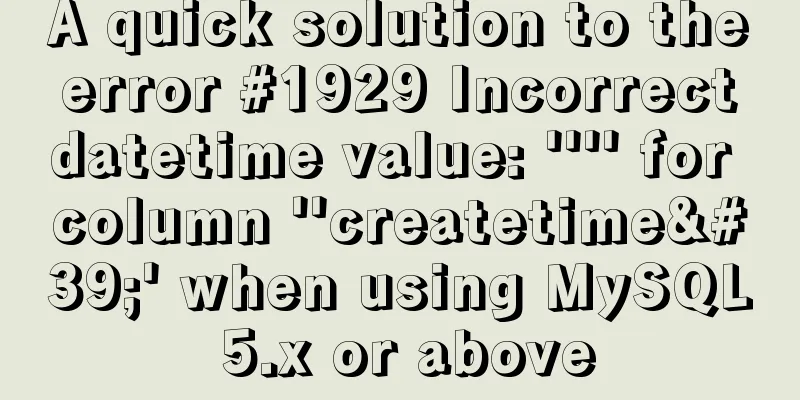Detailed explanation of Vue login and logout

|
First, let’s take a look at our effect implementation process. First log in to overview and business processes and related technical points
Login business process1. Enter your username and password on the login page 2. Call the backend interface for verification 3. After verification, jump to the project homepage according to the response status of the background Login function implementation1. First, we use the routing guard to verify the login and determine whether it is necessary to log in
{
path:'/login',
name:"login",
component:login,
meta:{
login:true
}
}
// Define meta-true where login is required to see if it is required if(to.matched.some(item=>item.meta.login)){//Login required console.log("Login required");
if(isLogin){//1. Already logged in, directly pass if(data.error===400){//The backend tells you that the login failed next({name:'login'})
localStorage.removeItem('token');
return;
}
if(to.name==='login'){
next({name:'Home'})
}else{
next()
}
return;
}
if(!isLogin && to.name==='login'){//2. Not logged in, but going to the login page next()
}
if(!isLogin && to.name !=='login'){//3. Not logged in, not the login page next({name:"login"})
}
}else{//No need to log in, go directly to next()
}2. For the form validation rules, we use the Element component library Use Element to write our style layout in the template
<div class="login-section">
<!-- :rules="rules" -->
<el-form
label-position="top"
label-width="100px" class="demo-ruleForm"
:rules="rules"
:model="rulesFrom"
status-icon
ref="ruleFrom"
>
<el-form-item label="username" prop="name">
<!-- Use v-model to get the name entered by the user -->
<el-input type="text" v-model="rulesFrom.name"></el-input>
</el-form-item>
<el-form-item label="password" prop="password"></el-form-item>
<!-- Use v-model to get the password entered by the user -->
<el-input type="password" v-model="rulesFrom.password"></el-input>
</el-form-item>
<el-form-item>
<!-- Define submit event -->
<el-button type="primary" @click="submitFrom('ruleFrom')">Submit</el-button>
<el-button>Reset</el-button>
</el-form-item>
</el-form>
</div>Define validation rules for the form
See Element official website from form for details Define in Data
rulesFrom:{
name:'',
password:''
},
rules:
name:[
// Validation rules {required:true,message:'Please enter your username',trigger:'blur'},
{min:1,max:5,message:'Length is between 1 and 5 characters',trigger:'blur'}
],
password:[
{required:true,message:'Please enter your password',trigger:'blur'},
{min:1,max:5,message:'Length is between 1 and 5 characters',trigger:'blur'}
]
}Define the submit event in methods
// When we click submit, the method can be triggered to get everything in the form submitFrom(formName){
this.$refs[formName].validate( (valid)=>{
if(valid){
// If the verification is passed, the user information and password will be returned to the backend login({
name:this.rulesFrom.name,
password:this.rulesFrom.password,
}).then((data)=>{
console.log(data);
if(data.code===0){
localStorage.setItem('token',data.data.token)
window.location.href='/';
}
if(data.code===1){
this.$message.error(data.message)
}
})
}else{
console.log('error submit!!');
return false
}
})
}At this time, write the logout and convert it in the router beforeEach
const token = localStorage.getItem('token');
// ! ! Token is converted to Boolean type const isLogin=!!token;
// When entering the route, you need to return the token to the backend to verify whether it is legal const data = await userInfo();
Store.commit('chageUserInfo',data.data)SummarizeThis article ends here. I hope it can be helpful to you. I also hope that you can pay more attention to more content on 123WORDPRESS.COM! You may also be interested in:
|
<<: Which one should I choose between MySQL unique index and normal index?
>>: How to install the latest version of docker using deepin apt command
Recommend
Axios secondary encapsulation example Demo in the project
1. Why do packaging? Facilitates overall code cal...
A few steps to easily build a Windows SSH server
The SSH mentioned here is called Security Shell. ...
Several methods to clear floating (recommended)
1. Add an empty element of the same type, and the...
Detailed explanation of the usage and function of MySQL cursor
[Usage and function of mysql cursor] example: The...
The most complete package.json analysis
Table of contents 1. Overview 2. Name field 3. Ve...
js implements simple provincial, municipal and district three-level selection cascade
This article shares the specific code of js to re...
Summary of 4 methods of div+css layout to achieve 2-end alignment of css
The div+css layout to achieve 2-end alignment is ...
v-for directive in vue completes list rendering
Table of contents 1. List traversal 2. The role o...
How to reset the root password in mysql8.0.12
After installing the database, if you accidentall...
Solution to ElementUI's this.$notify.close() call not working
Table of contents Requirement Description Problem...
How to automatically import Vue components on demand
Table of contents Global Registration Partial Reg...
An example of vertical centering of sub-elements in div using Flex layout
1. Flex is the abbreviation of Flexible Box, whic...
WeChat applet realizes horizontal and vertical scrolling
This article example shares the specific code for...
Tutorial on using prepare, execute and deallocate statements in MySQL
Preface MySQL officially refers to prepare, execu...
Vue imitates Ctrip's carousel effect (sliding carousel, highly adaptive below)
Let's look at the case first. Use vue+swiper ...










